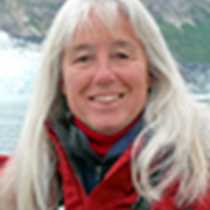Pavlof Harbor/Chatham Strait
The Sea Lion cruised southeast from Glacier Bay through Chatham Strait during the night and entered Freshwater Bay this morning. We anchored in a small cove known as Pavlof Harbor (Chichagof Island) and commenced our hiking and kayaking activities after breakfast. A beautiful shoreline, salmon stream, and waterfall made for a pleasant experience from both the water and the land. As a bonus, a brown bear fishing below the falls added an exciting dimension. Here we had all the components connecting the ocean, the salmon, the bears and the forest. The salmon bring nutrients from the ocean that feed the bears, eagles, and other denizens of the forest, and also nourish the next generation of salmon and even the trees themselves. As an encore to the morning, two young brown bears, probably siblings recently separated from their mother, wandered onto the beach in sight of the kayakers and walked past our gear on the shore on their way to the falls to gorge on fish. What a thrill!
Before we pulled the anchor, there was a call for all those who wanted to go swimming. The water was a balmy 57 degrees and six intrepid guests went for a quick(!) refreshing dip before lunch while others cheered and took photographs.
Sharing our anchorage in Pavlof Harbor was a vessel named the Evolution, floating home to humpback whale researchers of the Alaska Whale Foundation. Started by Dr. Fred Sharpe in 1995, this non-profit conservation organization is supported by Lindblad Expeditions and its guests. We invited the researchers onboard the Sea Lion and headed north in search of some whales. We hit the jackpot when we came upon a group of about 15 humpbacks cooperatively bubblenet feeding! This efficient method of food acquisition involves creating a column of bubbles that entraps herring, causing them to concentrate so that the whales can come up through the middle with mouthfuls of fish. Fred Sharpe and Sean Hanser shared the microphone and described what was happening and what they have learned through their study of the social biology of these whales. We also deployed a hydrophone (underwater microphone) from the bow of the ship to listen to the feeding sounds, which helped us anticipate when the whales would rise. Over and over we watched and listened in awe as they erupted at the surface in a jumble of body parts. It was certainly an extraordinary experience we were lucky and privileged to observe today. There is still much to learn about whales and continued study of the whales will promote conservation through science.
High energy and excitement from our remarkable day remained with us into the evening as we headed southeast toward our next day’s adventures.
The Sea Lion cruised southeast from Glacier Bay through Chatham Strait during the night and entered Freshwater Bay this morning. We anchored in a small cove known as Pavlof Harbor (Chichagof Island) and commenced our hiking and kayaking activities after breakfast. A beautiful shoreline, salmon stream, and waterfall made for a pleasant experience from both the water and the land. As a bonus, a brown bear fishing below the falls added an exciting dimension. Here we had all the components connecting the ocean, the salmon, the bears and the forest. The salmon bring nutrients from the ocean that feed the bears, eagles, and other denizens of the forest, and also nourish the next generation of salmon and even the trees themselves. As an encore to the morning, two young brown bears, probably siblings recently separated from their mother, wandered onto the beach in sight of the kayakers and walked past our gear on the shore on their way to the falls to gorge on fish. What a thrill!
Before we pulled the anchor, there was a call for all those who wanted to go swimming. The water was a balmy 57 degrees and six intrepid guests went for a quick(!) refreshing dip before lunch while others cheered and took photographs.
Sharing our anchorage in Pavlof Harbor was a vessel named the Evolution, floating home to humpback whale researchers of the Alaska Whale Foundation. Started by Dr. Fred Sharpe in 1995, this non-profit conservation organization is supported by Lindblad Expeditions and its guests. We invited the researchers onboard the Sea Lion and headed north in search of some whales. We hit the jackpot when we came upon a group of about 15 humpbacks cooperatively bubblenet feeding! This efficient method of food acquisition involves creating a column of bubbles that entraps herring, causing them to concentrate so that the whales can come up through the middle with mouthfuls of fish. Fred Sharpe and Sean Hanser shared the microphone and described what was happening and what they have learned through their study of the social biology of these whales. We also deployed a hydrophone (underwater microphone) from the bow of the ship to listen to the feeding sounds, which helped us anticipate when the whales would rise. Over and over we watched and listened in awe as they erupted at the surface in a jumble of body parts. It was certainly an extraordinary experience we were lucky and privileged to observe today. There is still much to learn about whales and continued study of the whales will promote conservation through science.
High energy and excitement from our remarkable day remained with us into the evening as we headed southeast toward our next day’s adventures.




